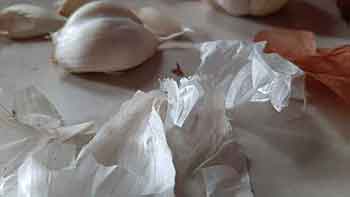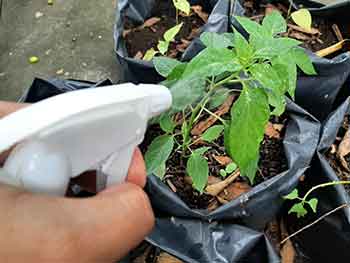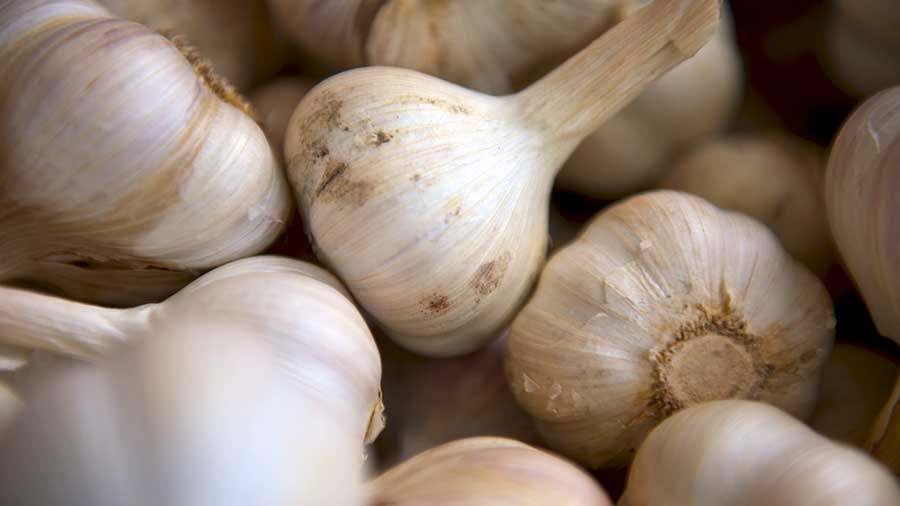One of the most common wastes in the kitchen is garlic peels. I have used garlic as a dressing (mixed with virgin olive oil), dips, flavoring for soups, and spices for various stuffing. I even like to mix it with my pasta sauce. Every day, garlic peels are found in the kitchen. How many times do we just throw away the peels in the trash?
In my container garden, kitchen wastes are actually one of my primary sources of organic fertilizers. Is garlic peel a good fertilizer for plants? Garlic is rich in potassium, calcium, and phosphorus. In fact, 3 cloves of garlic (about 9 grams) contain 36.09 mg of potassium, 16.29 mg of calcium, 2.25 mg of magnesium, and 13.77 mg of phosphorus.
Potassium (K) and phosphorus (P) are 2 of the 3 basic micronutrients needed by plants in order to thrive. The other one is nitrogen.
Potassium is needed by plants to produce more flowers and fruits. It helps plants in reaching maturity by playing a big role in the absorption of water and nutrients from the soil. Phosphorus is responsible for root development, while calcium makes the plant sturdy.
The Role of Potassium in Plant Growth
Potassium is one of the primary nutrients needed by plants. The 3 primary nutrients that are essential to the growth and reproduction of plants are Nitrogen (N), Phosphorus (P), and Potassium (K). Nitrogen is for the production of chlorophyll. It makes the leaf green.
If the leaves of a plant turn yellow, it is a sure sign of nitrogen deficiency. Potassium, on the other hand, is responsible for:
- better photosynthesis
- absorption of water and nutrients
- flower and fruit production
- making the plant strong and sturdy
- strengthening the plant immune system
- ensuring bigger and more tasty fruits
The Role of Phosphorus in Plant Growth
Phosphorus is able to do the following:
- Helps in overall plant growth
- Helps in flower and fruit setting
- Helps plant reach maturity
- Ensures proper root development
- Increases the growth rate of plants
Signs of phosphorus-deficiency in plants include:
- Slow growth
- Zero to low flower production
- Flowers are dropping
- Discoloration of leaves (leaves are turning purple starting from the lower part)
- Presence of dark spots in the leaves
The Role of Calcium and Magnesium in Plant Growth
You can also get small amounts of magnesium and calcium from garlic peels. Both magnesium and calcium are secondary nutrients because plants need them in smaller amounts as compared to the primary nutrients.
According to the Mississippi State University, magnesium is the central core of the chlorophyll molecule in plant tissue. Thus, if Mg is deficient, the shortage of chlorophyll results in poor and stunted plant growth. Magnesium also helps to activate specific enzyme systems.
Enzymes are complex substances that build, modify, or break down compounds as part of a plant's normal metabolism.
The primary function of calcium in plant growth is to provide structural support to cell walls. Calcium also serves as a secondary messenger when plants are physically or biochemically stressed.
Burying the Garlic Peels in the Soil
Like all organic matter, garlic peels can simply be buried and turned into compost. This process involves good microorganisms in the soil breaking down the organic matter. As the microbes break down the garlic peels, it leeches the potassium into the soil which will then be absorbed by the plant.
However, one downside to this is the time it takes for the garlic peels to decompose. This is sometimes referred to as a slow-release type of fertilizer. It could take a few weeks or months before the garlic peels begin to give up their precious nutrients.
Digging into the soil also poses a problem. You could end up destroying the roots while digging. Be careful when digging holes in the soil.
Making a Garlic Peel Tea Fertilizer
A safer way to use garlic peel as fertilizer is to make it into a tea. Well, technically it is called an infusion. When you pour boiling or very hot water on fresh or dried parts of a plant and let it soak or steep for a minute or two, you’re generally preparing a tea.
In this case, we will be soaking the garlic peels in water. But to get the most benefit out of the garlic peels, you may need to let it steep longer. When you do this, you’re now making an infusion. The main idea here is to let the water absorb the nutrients from the garlic peels.

Here are the steps in making a garlic peel tea fertilizer:
- Place the garlic peels in a glass or plastic container.
- Add water. What I do is for every 1 liter of water, I use 2 bulbs of garlic peelings.
- Mix thoroughly. With the lid tightly sealed, I just simply vigorously shake it.
- Let it sit for 24 hours.
- Store in a cool dry area, away from sunlight.
After 24 hours, the water becomes brownish in color. Some bubbles may appear. This is normal. To use, remove all solid particles by straining. You can use it directly to water the plants. Or you can use it to spray directly to leaves and flowers.
This fertilizer can be used during the seedling, vegetative, and flowering, and fruiting stage of the plant. When the plant is in its flowering stage, you should avoid spraying the garlic peel tea directly on the flowers.
Insects tend to avoid the smell of garlic, even the good ones, so don’t apply on flowers as they may interfere with pollination and the flowers will not develop into fruits.
Apply the garlic peel tea fertilizer once a week.
Garlic Peel Tea Used as Foliar Fertilizer
The best way to apply the garlic peel tea to your plants is to use it as a foliar fertilizer. Foliar feeding is when the fertilizer is applied directly to the leaves of a plant, usually through spraying. With foliar feeding, the nutrients are absorbed directly through the leaves of the plant.

The leaves absorb the nutrients through the stomata. It is best to spray the fertilizer in the early morning or late afternoon. This is when the plant’s stomata are open. To use it as a spray, you just need to filter the solid particles before putting the liquid into the spray container.
Garlic as a Pest Repellant Spray
Aside from being used as a fertilizer, garlic can also be used as an organic pesticide. This is my recipe for making a pest repellant from garlic. I use this to get rid of soft-bodied insects such as aphids and those pesky leafminers.
Ingredients
2 bulbs garlic
1 liter water
½ cup vegetable oil *if not available, you may use any cooking oil
1 tablespoon liquid soap
Procedure
Chop the garlic into small pieces. Using a blender, mix the garlic in 1 liter of water. Let the mixture sit overnight. Afterward, remove the solid particles. I use a clean strainer to separate the liquid. Next, add in the vegetable oil and the liquid soap. Mix thoroughly.
To use, dilute the mixture in water. The dilution rate is 500 ml/liter of water. Spray once to twice a week. You can use the mixture for up to a month. Just keep it in a cool, dry area away from direct sunlight. Make sure to cover it tightly.
Nutrition data of garlic is taken from nutritionvalue.org










